Bloom’s Taxonomy: A Comprehensive Guide and Questions Dictionary for Educators

Bloom’s Taxonomy is a framework for crafting effective learning objectives and assessments. But what specific questions fall under this model?
- How are Bloom’s Taxonomy questions structured?
- Can they be applied to different subjects like math and science?
- What makes a Bloom’s Taxonomy question higher-level?
Dive in to uncover a comprehensive dictionary of Bloom’s Taxonomy questions for educators!
Table of Contents
Understanding Bloom’s Taxonomy
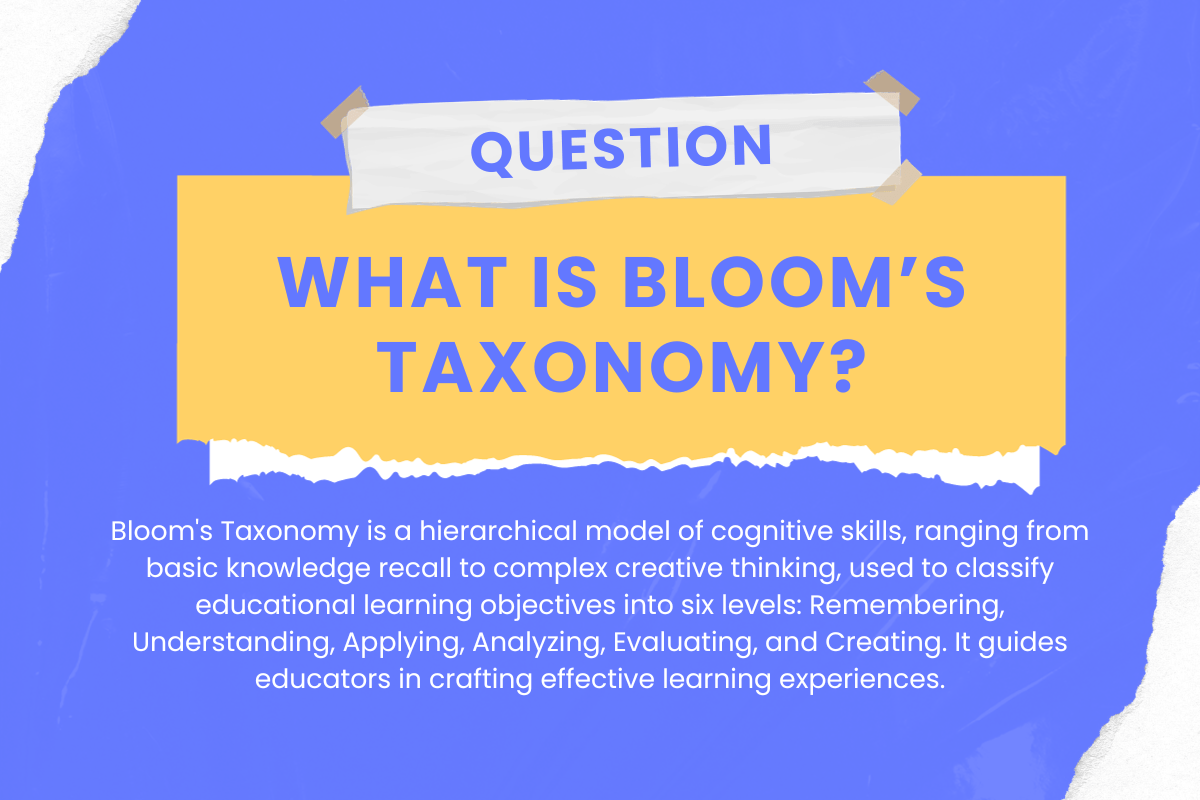
Bloom’s Taxonomy isn’t just a fancy term educators toss around in conferences or meetings. It’s a meticulously structured hierarchy, developed by Benjamin Bloom back in the 1950s, that classifies thinking behaviors essential for learning. Let’s unwrap its layers to genuinely appreciate its significance.
- Remember: This is the foundational step. It’s all about remembering facts. Imagine a student memorizing multiplication tables; that’s the knowledge level in action. But while it’s essential, it’s just the beginning.
- Understand: Now that you’ve memorized, can you understand? This stage challenges students to grasp the meaning of the information, like interpreting the primary theme of a poem. It’s not just about parroting back facts; it’s about making sense of them.
- Apply: Here’s where things get hands-on. Can students use the knowledge in a new way? Like using the Pythagorean theorem – not just reciting it, but applying it to a real-world problem, perhaps in architecture or engineering.
- Analyse: Analyze, dissect, compare. This level nudges students to break information into parts and understand structures. For instance, in a science experiment, can they identify the variables, methods, and outcomes?
- Evaluate: The pinnacle of cognitive skills. Here, students assess values, make judgments, and justify decisions. They might be tasked with debating the ethics of a historical event or critiquing a piece of art.
- Create: Creativity comes to play. This stage is about combining elements to form a new pattern or structure. Think of it as creating a new story by merging elements from different fairy tales.
Several studies, like the one from Educational Psychologist Lorin Anderson, suggest that the mastery of lower levels paves the way for effective engagement with higher-level tasks.
In fact, for subjects like math or science, the synthesis of various Bloom taxonomy questions can lead to a profound understanding of complex topics.
Bloom Taxonomy Stages and Questions Examples
At the heart of effective teaching lies the ability to ask the right questions. And the Bloom Taxonomy questions framework is an educator’s goldmine, providing a structured pathway to challenge students across cognitive levels.
Let’s delve deeper into specific examples across subjects, illustrating the taxonomy’s practical utility in classrooms.
Bloom’s Taxonomy Stage 1: Remember
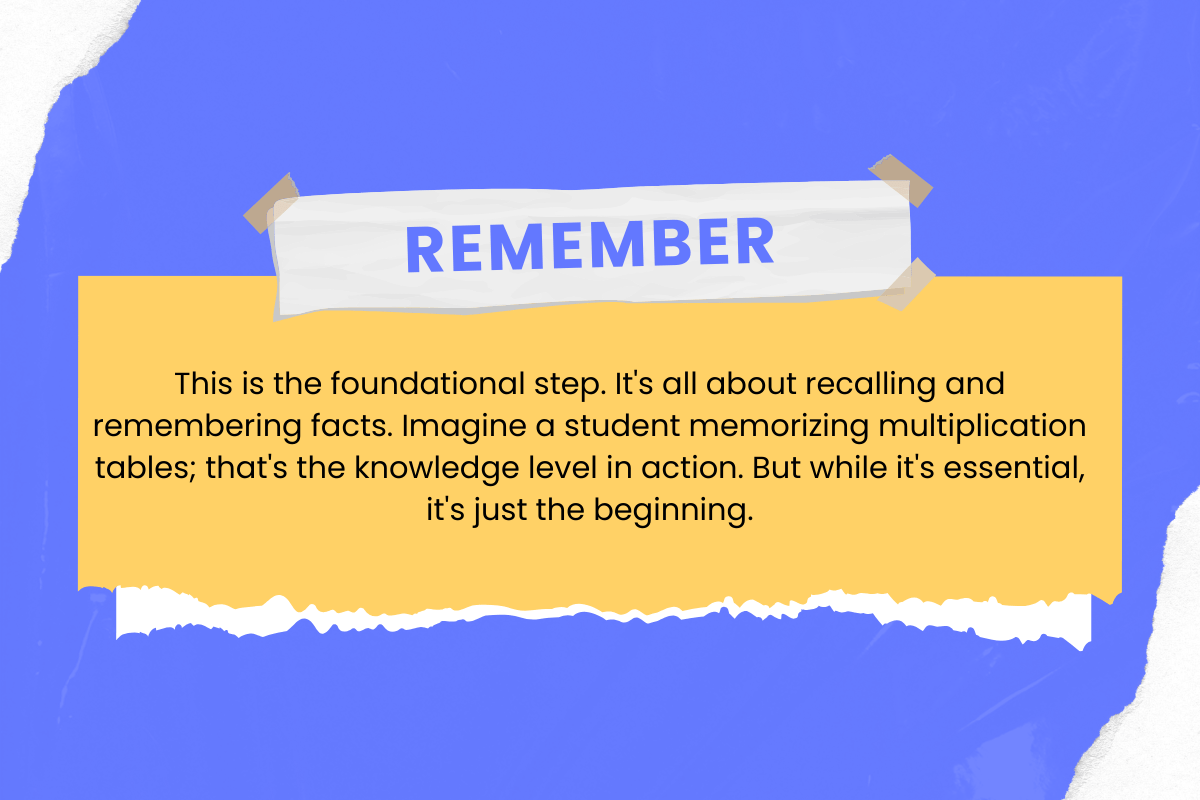
The base of Bloom’s pyramid, the “Knowledge” level, is the stepping stone to all higher-order thinking skills. But make no mistake—just because it’s the foundation doesn’t mean it’s simplistic. At this stage, students absorb raw facts and figures, laying the groundwork for more complex cognitive tasks.
Remember the Facts
Remember is the ability to retrieve information verbatim without necessarily understanding its underlying context. It’s the initial stage of memory retrieval. For instance, remember the capitals of countries or the dates of historical events.
🧠 Examples of Remember Questions
- “What is the capital of Italy?”
- “List the primary colors.”
- “Recite the first 10 elements of the periodic table.”
- “When did the American Civil War start?”
Recognize: A Step Beyond Recall
Recognition is slightly more complex than recall. It involves identifying information when you see or hear it, typically from a list of options. It’s like recognizing a familiar face in a crowd or identifying the right answer in a multiple-choice question.
🧠 Examples of Recognition Tasks
- Choosing the correct formula to solve a math problem from a list.
- Identifying the correct definition of a word from multiple options.
- Picking out the musical instrument being played in a composition.
- Selecting the right interpretation of a poem from given choices.
Interestingly, according to cognitive science experts like Dr. Robert Bjork, recognition tasks often use different neural pathways than recall tasks. This suggests that, even at the foundational “Knowledge” level, students engage with information in varied ways.
Remember: While the "Knowledge" stage of Bloom taxonomy questions might seem basic, it's crucial for solidifying the fundamentals. Teachers can employ a mix of recall and recognize exercises, ensuring students have a robust memory bank to draw from as they ascend Bloom's hierarchy.
Bloom’s Taxonomy Stage 2: Understand
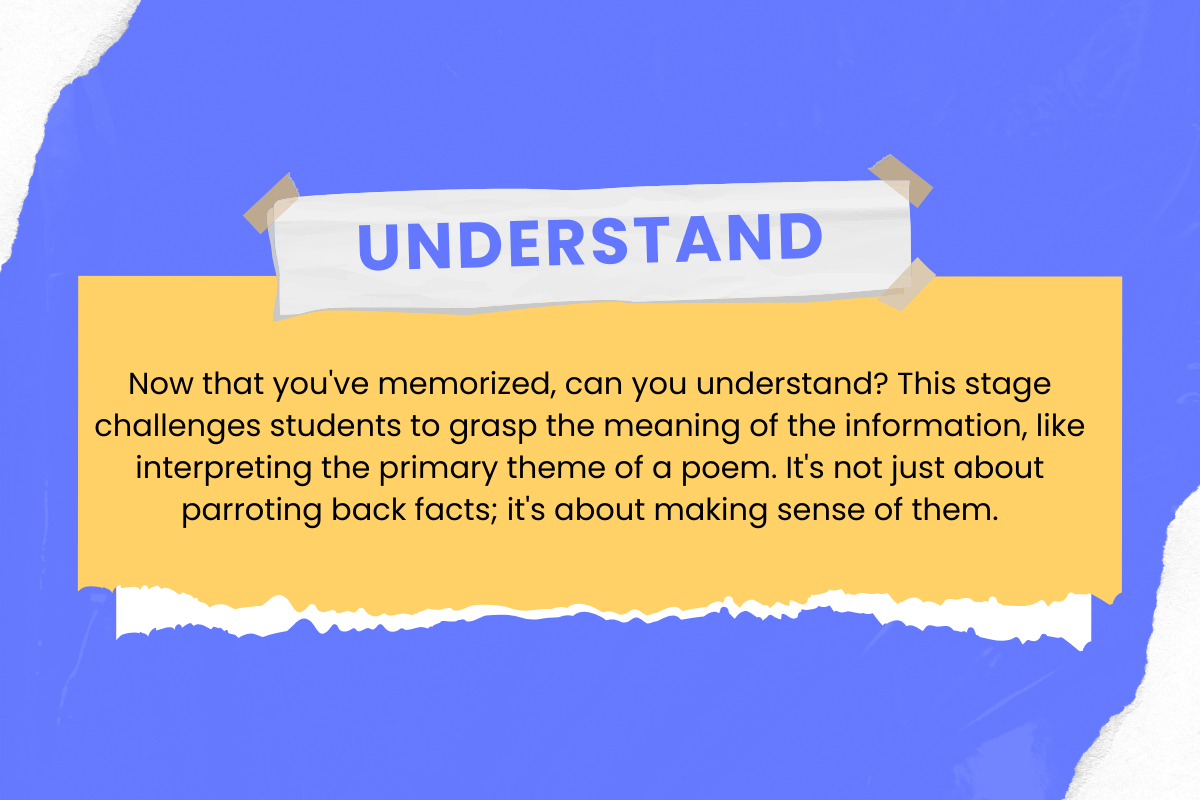
Comprehension, a critical step in Bloom’s Taxonomy, involves not just absorbing information but truly understanding it. Students delve into the “why” and “how” behind concepts, ensuring they can explain and translate information in their own words.
Decoding the Layers of Understanding
True comprehension extends beyond rote learning. It entails grasping nuances, interpreting facts, and drawing logical connections.
🧠 Examples of Understanding Questions
- “Explain the main idea of this passage in your own words.”
- “How would you summarize this chapter to a friend who hasn’t read it?”
- “What does this graph indicate about the relationship between X and Y?”
- “Can you paraphrase what the author is saying about the protagonist’s journey?”
- “Describe the process of photosynthesis to someone unfamiliar with the concept.”
- “How would you interpret the theme of the poem we just read?”
🧠 Examples of Understanding Tasks
- Explaining the water cycle in one’s own words after studying it.
- Translating a complex scientific principle into a simple analogy or metaphor.
- Interpreting the emotions and motivations of a character in literature.
- Summarizing the core argument of an essay or article.
The Elegance of Explanation
Being able to explain a concept signifies a profound grasp over the material. It’s an affirmation that a student can not only digest information but also relay it effectively to others.
🧠 Examples of Explanation Activities
- Demonstrating how photosynthesis works using a diagram.
- Articulating the steps of a math problem and why each step is essential.
- Detailing the significance of a historical event in shaping society.
- Outlining the cause-effect chain in a scientific phenomenon.
The Harvard Graduate School of Education posits that when students are tasked with explaining concepts, it fortifies their understanding and uncovers gaps in their knowledge. This process is transformative; it cultivates deeper thinking and reflective learning.
Bloom’s Taxonomy Stage 3: Apply
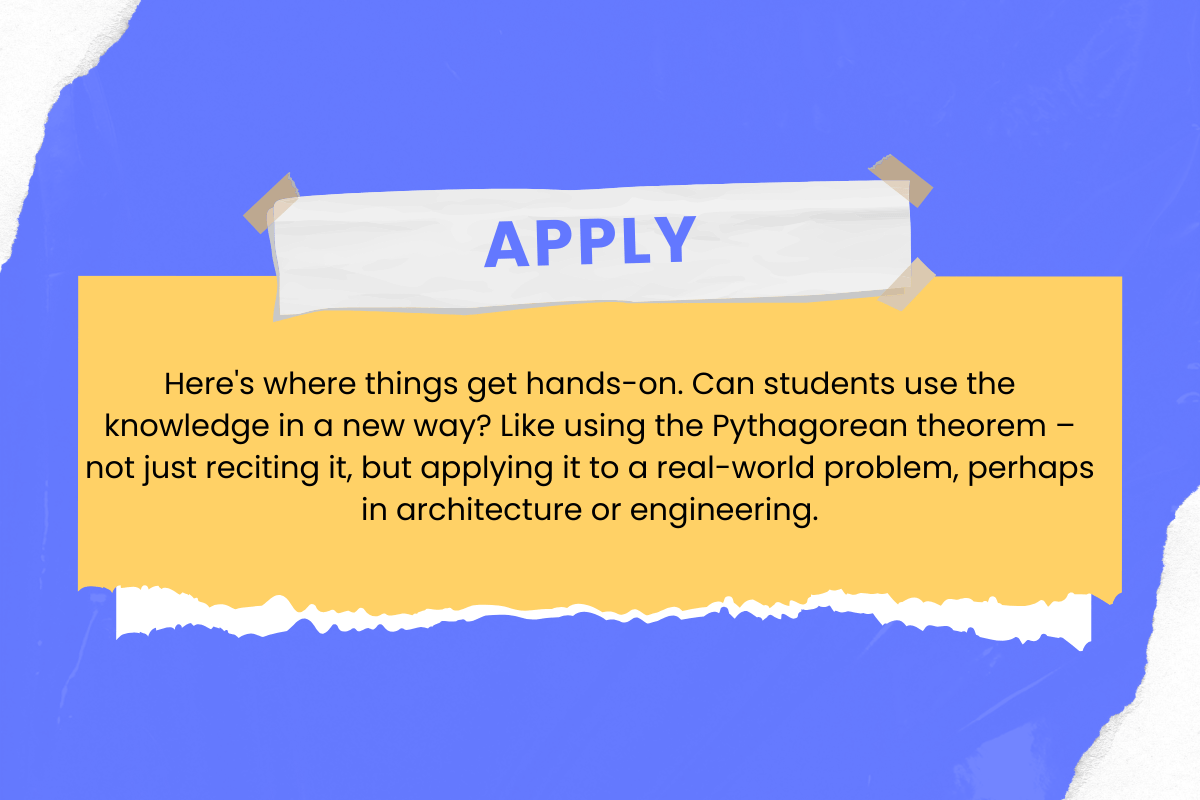
The “Application” level in Bloom’s Taxonomy propels students from merely knowing information to applying it in novel scenarios. It’s not just about retaining or understanding; it’s about putting that knowledge into practice, a critical leap in cognitive development.
Breaking Down “Use” in Learning
Using knowledge requires students to implement what they’ve learned in real-world or hypothetical situations. This hands-on approach solidifies understanding and often reveals areas that need reinforcement. For instance, applying mathematical concepts to solve everyday problems.
🧠 Examples of Using Knowledge
- Solving a real-life math problem, like determining the discount on a sale item.
- Creating a chemical reaction in a lab using learned principles.
- Writing a short story in a foreign language class.
- Designing a basic electrical circuit in physics.
Demonstrate: Showcasing Applied Knowledge
Demonstration is a potent learning tool and assessment strategy. It asks students to show, rather than tell, their grasp on a subject. It’s one thing to know the theory behind a concept; it’s another to demonstrate mastery over it.
🧠 Examples of Demonstration Questions
- “How would you use the Pythagorean theorem to determine the length of the third side of this triangle?”
- “Given what you’ve learned about the water cycle, how would you explain the formation of clouds?”
- “If you were a character in the story, how would you have reacted in the same situation?”
- “How can you demonstrate the law of conservation of energy using a simple experiment?”
- “Given the principles of supply and demand, how would you predict the price movement of a product with increasing demand but decreasing supply?”
- “How would you apply the concept of photosynthesis in setting up an efficient greenhouse?”
- “Using the grammar rules we’ve discussed, can you construct a complex sentence that conveys a specific mood?”
🧠 Examples of Demonstration Tasks
- Building a model ecosystem in biology.
- Conducting an experiment to test a scientific hypothesis.
- Demonstrating a dance move in physical education.
- Presenting a case study solution in business studies.
According to Edutopia, active application and demonstration of knowledge can enhance memory retention and understanding. This goes beyond rote memorization, pushing students to internalize and master content.
Bloom’s Taxonomy Stage 4: Analyse
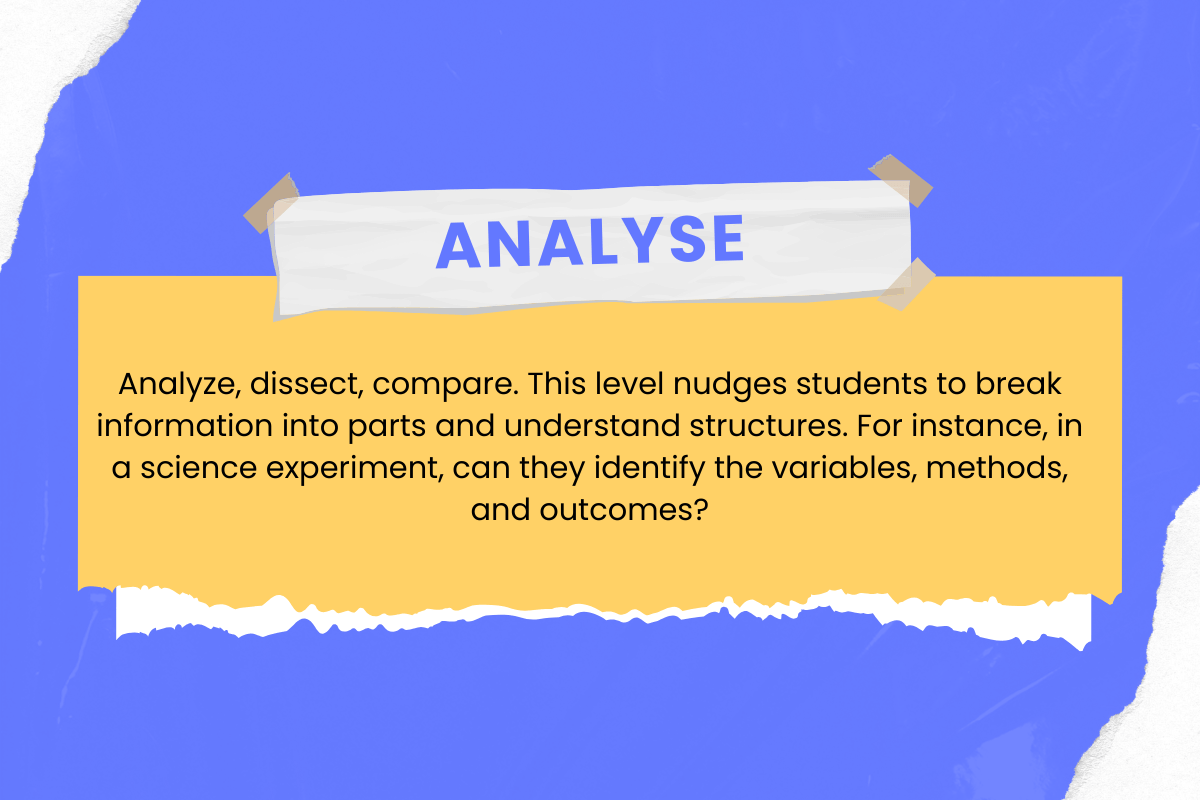
The “Analysis” phase of Bloom’s Taxonomy steers students into a realm where they can dissect, differentiate, and organize information. At this juncture, learners move beyond mere knowledge application, diving deeper to understand the intricate components of a topic and how they interrelate.
The Art of Differentiation
Differentiating is about discerning subtle differences and similarities. Students are prompted to critically examine and separate components to understand their distinct roles or characteristics. This keen observation skill is vital across numerous academic subjects.
🧠 Examples of Differentiating Questions
- What patterns can you identify in the data presented in this graph?”
- “How would you differentiate between the arguments made by Author A and Author B?”
- “Which parts of this experiment were crucial in determining the final outcome?”
- “What inferences can you make from the protagonist’s actions in the story?”
- “Based on the historical document, can you identify the underlying causes of the event?”
- “What relationships do you see between these two scientific concepts?”
- “How would you deconstruct this piece of art to understand its symbolic elements?”
🧠 Examples of Differentiating Tasks
- Comparing and contrasting the themes of two literary works.
- Identifying the different causes of World War I and World War II.
- Distinguishing between aerobic and anaerobic respiration in biology.
- Spotting the stylistic variations between two art movements.
Organization: Building Structured Understanding
To organize is to structure or categorize information, fostering a clear and hierarchical comprehension of topics. Here, students prioritize, arrange, and cluster data or concepts, making the abstract tangible and digestible.
🧠 Examples of Organizational Activities
- Categorizing animals based on their habitats or dietary habits.
- Constructing a timeline of significant events leading up to a historical revolution.
- Organizing chemical elements based on their properties in the periodic table.
- Grouping mathematical problems based on solution strategies.
A study from Stanford University emphasizes that analytical tasks, especially ones centered around differentiation and organization, sharpen students' cognitive abilities. They help hone critical thinking, paving the way for more complex cognitive tasks.
Bloom’s Taxonomy Stage 5: Evaluate
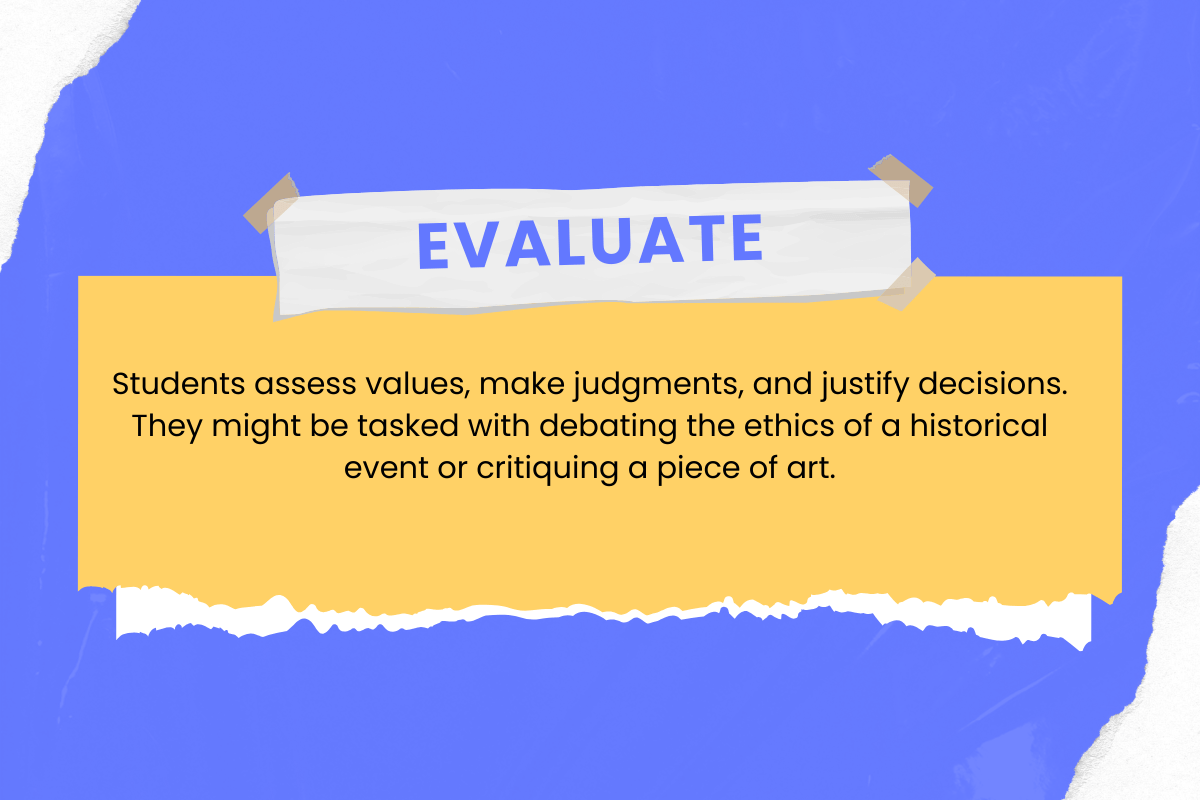
Sitting atop the hierarchy of Bloom’s Taxonomy, the evaluation stage requires critical discernment and the formulation of judgments based on a set of criteria. It isn’t just about identifying the pros and cons but taking that a step further to offer suggestions or make informed decisions.
Decoding the Judging Process
Evaluation doesn’t merely rely on surface-level observation. It involves an intricate process of comparing, contrasting, and making conclusions based on evidence and relevant criteria.
🧠 Examples of Judging Questions
- “Based on the evidence presented, can you justify the author’s conclusions in the article?”
- “Which method discussed in class do you think is most effective for solving this problem, and why?”
- “How would you assess the credibility of this source in relation to our topic?”
- “In comparing these two characters, who do you believe showed greater resilience, and what evidence supports your view?”
- “Based on our discussions, which historical event had the most significant impact on modern society? Defend your choice.”
🧠 Examples of Judging Scenarios
- Reviewing a novel and determining its literary merits in comparison to other works in the genre.
- Analyzing the effectiveness of a marketing campaign using defined KPIs.
- Scrutinizing the ethical implications of a new technology or innovation.
- Appraising the potential success of a startup based on market trends, team competency, and financial viability.
Stepping into Recommendations
Post-judgment, the evaluation stage often dovetails into providing actionable insights or recommendations. This synthesis of judgment and foresight is crucial for informed decision-making.
🧠 Examples of Recommending Instances
- Suggesting improvements for a mobile application after evaluating its user interface and user reviews.
- Proposing policy changes after assessing the environmental impact of an industrial project.
- Recommending a patient’s treatment plan after evaluating their medical history and current health status.
A Harvard Business Review article highlights the increasing importance of evaluative skills in modern workplaces. Decision-making, now more than ever, requires employees to rapidly assess situations, weigh alternatives, and recommend optimal paths forward.
Bloom’s Taxonomy Stage 6: Create
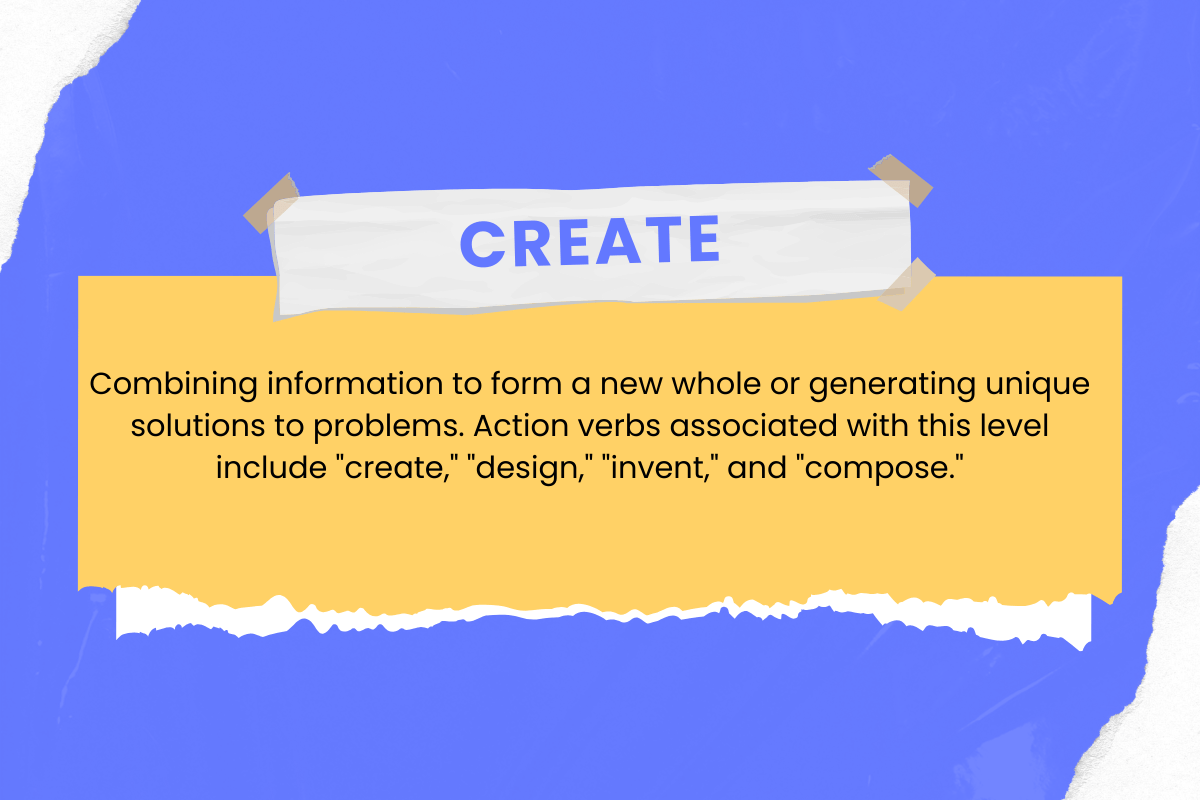
Culminating Bloom’s hierarchy, the Creating level, is where students are tasked to put pieces together in a novel pattern, devise new solutions, or form a unique perspective.
What Does Create Really Mean?
Creation is the culmination of all prior cognitive stages. Students use their knowledge, comprehension, application, analysis, and evaluation skills to produce something new. This could be as abstract as a theory or as tangible as a model or prototype.
🧠 Examples of Create Questions
- “If you were to design a new ending to this story, how would it unfold and why?”
- “Can you devise a new experiment that would expand on the findings from our previous lab?”
- “How would you combine the themes of two different books to create a new, original story?”
- “Based on the historical events we studied, can you craft a hypothetical ‘what if’ scenario and predict its outcomes?”
- “Imagine you’re tasked with creating a new product that solves a current environmental issue. What would it be?”
- “Can you compose a poem that integrates five different literary devices we’ve discussed this semester?”
- “Using the principles of geometry, design a unique structure that serves a specific purpose in a community.”
🧠 Examples of Create Tasks
- Storytelling from Prompts: Provide students with a set of random images or words. Ask them to craft a unique, cohesive story that connects all the elements.
- Invent a Game: Challenge students to design a board game or card game that teaches a particular concept they’ve learned. They should come up with rules, design game pieces, and explain the educational aspect.
- Concept Mashup: Ask students to merge two unrelated concepts or subjects they’ve studied to create something new. For instance, combining historical events with futuristic technology to envision a new world.
Incorporating the bloom taxonomy higher level questions in subjects like math or science can lead to groundbreaking student-led discoveries. For instance, posing a question about creating a new solution to an age-old math problem could yield surprising insights.
Incorporating Technology into Bloom’s Taxonomy Teaching
In an age where technology reigns supreme, educators and presenters are continually seeking innovative ways to captivate their audience and make learning both engaging and effective. Enter ClassPoint AI, a groundbreaking tool that automates Bloom’s Taxonomy question generation based on your PowerPoint slide content.
AI-Powered Bloom Taxonomy Quiz Question Generation
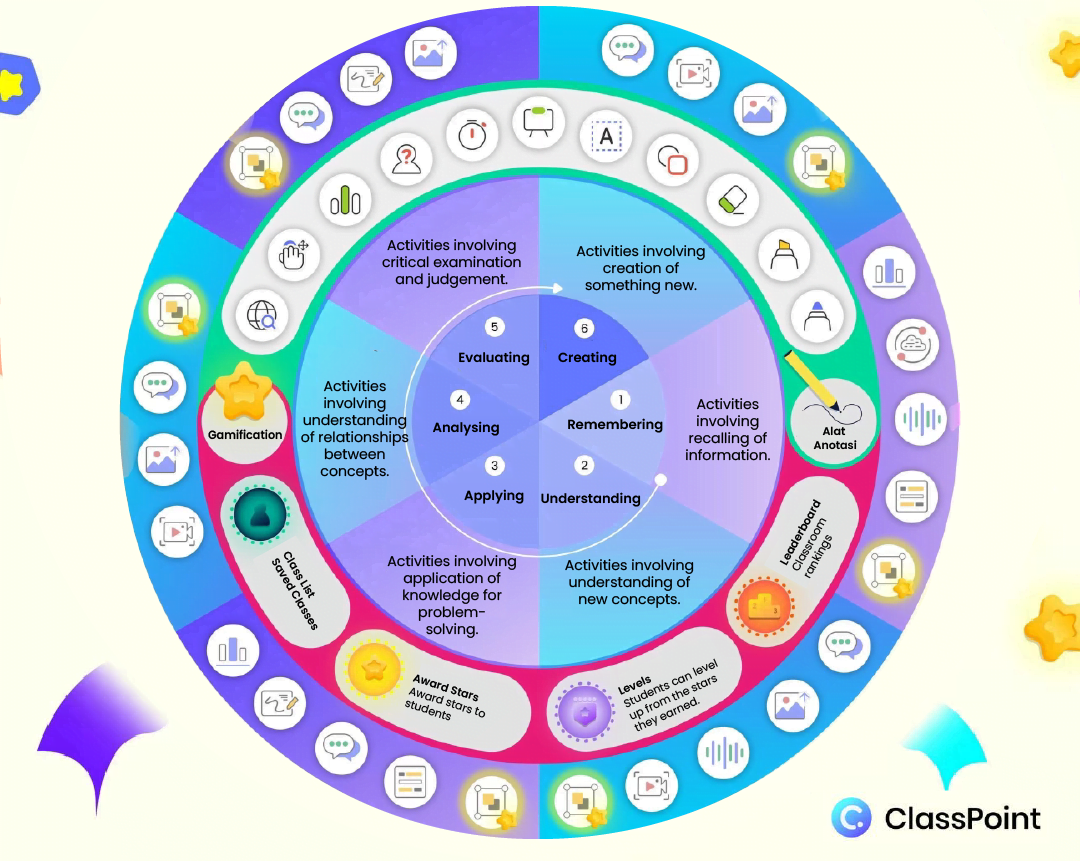
Try these teaching tools to integrate your teaching seamlessly with the Bloom’s Taxonomy framework:
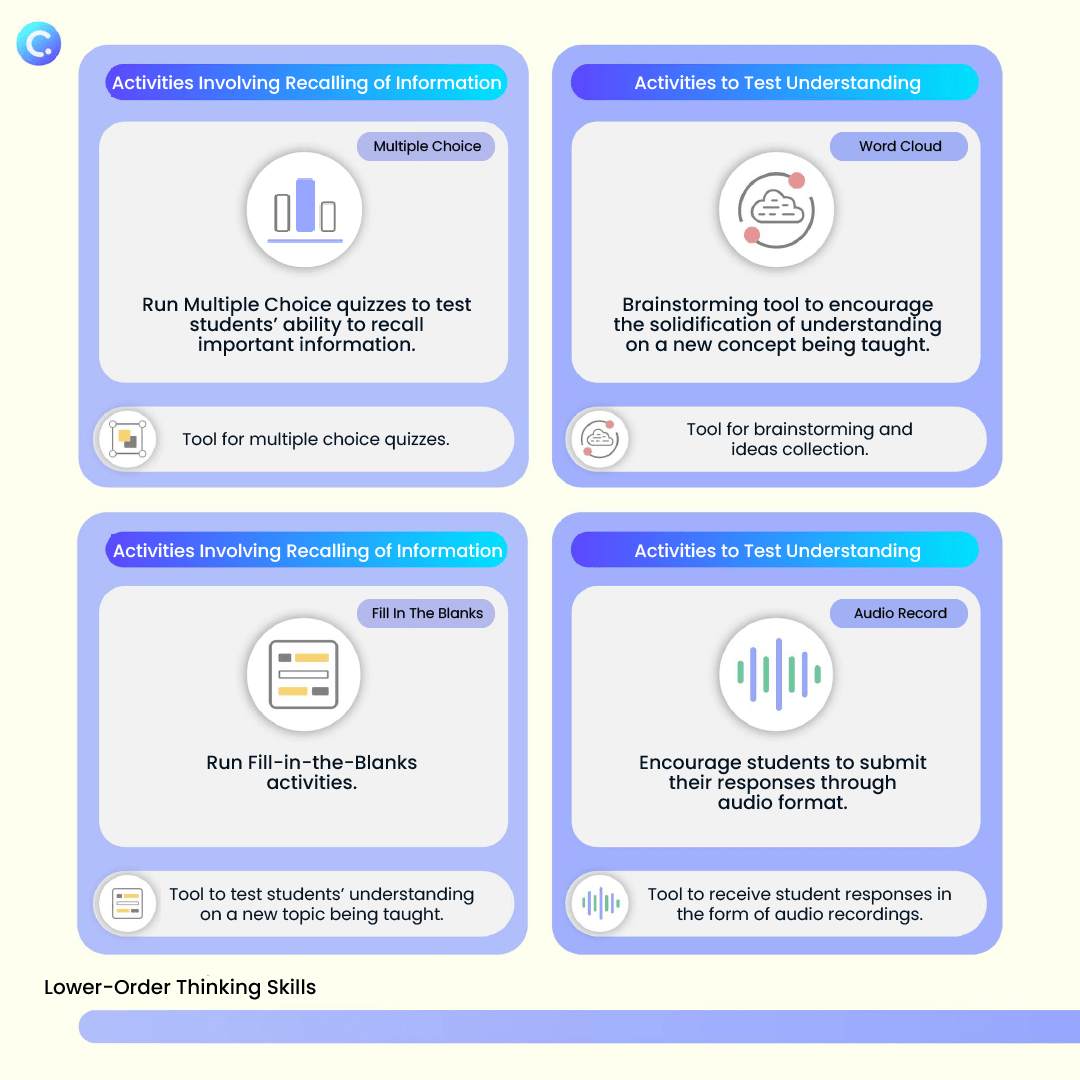
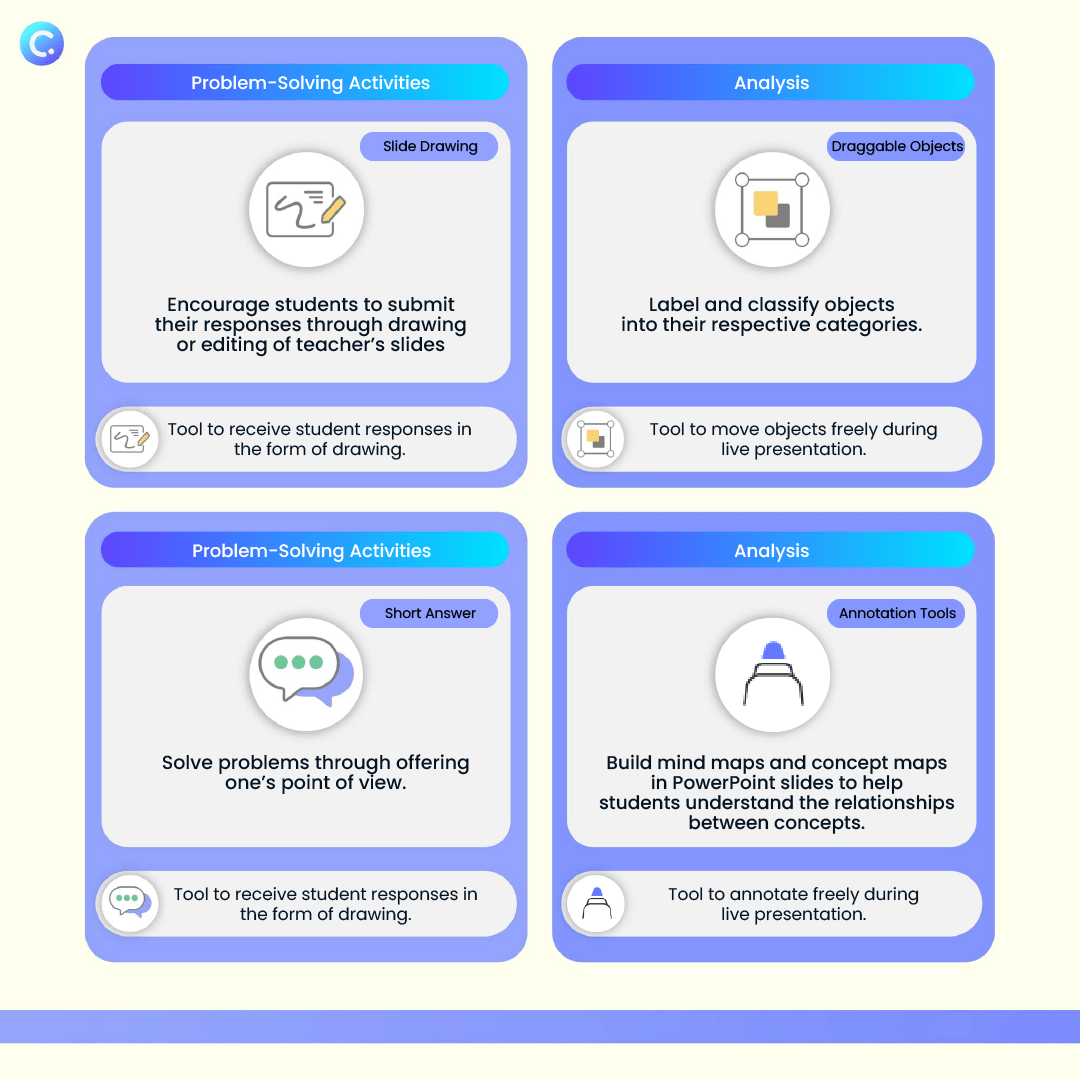
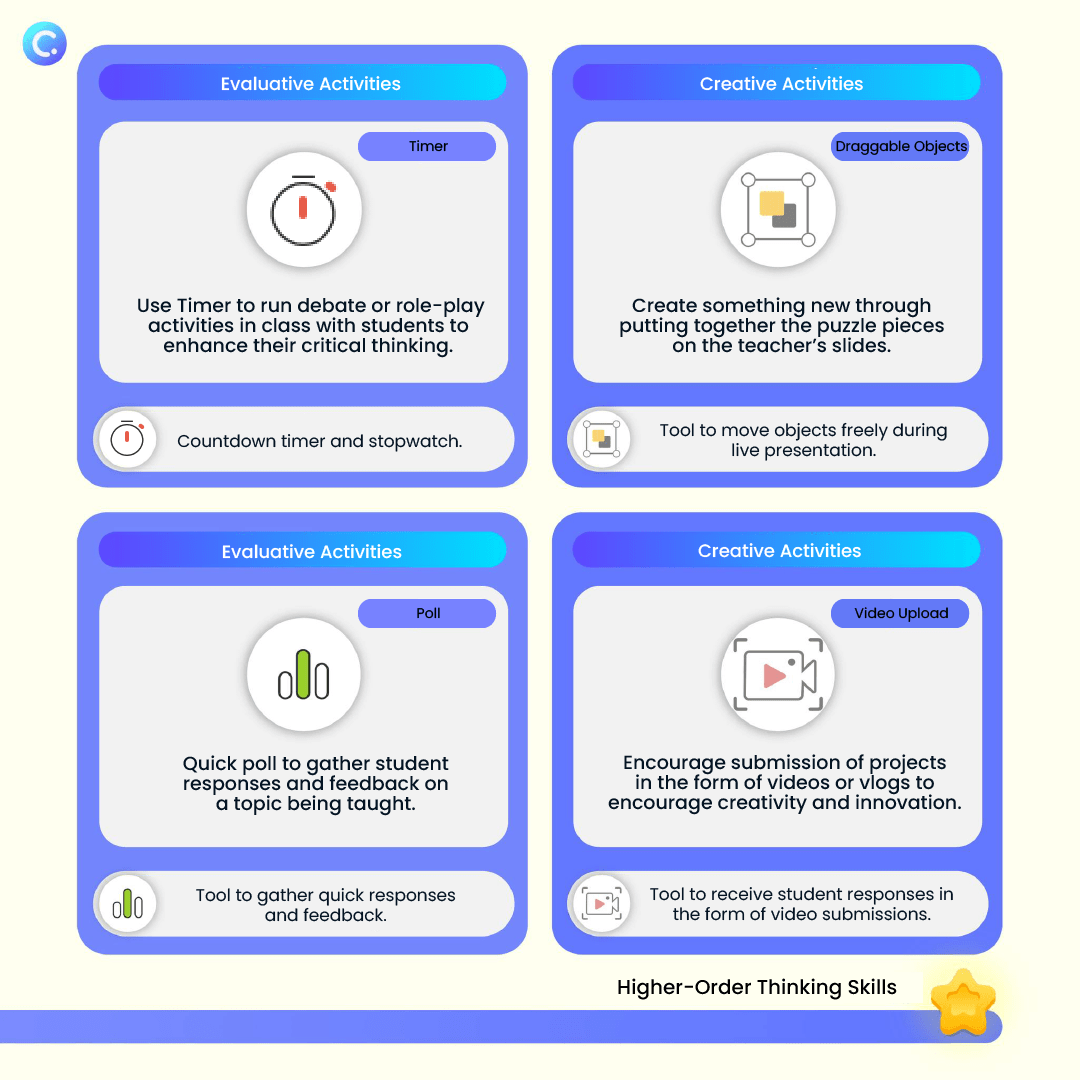
Other Real-World Applications
While ClassPoint AI is undeniably a boon for educators, its utility extends far beyond traditional classrooms:
- Corporate Training Sessions: Trainers can leverage ClassPoint AI to gauge employee comprehension during workshops, making training sessions more interactive and effective.
- Webinars and Online Workshops: Presenters can integrate quizzes to maintain audience engagement and receive instant feedback.
- Language Academies: Language instructors can create custom quizzes in various languages, aiding in more nuanced language learning and comprehension.
Here are some resources you might find interesting to get you started 👇













